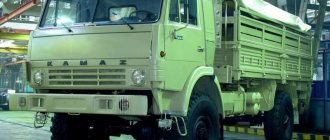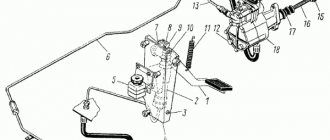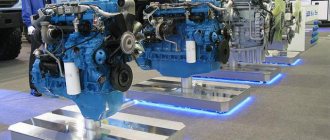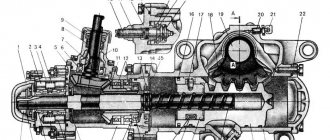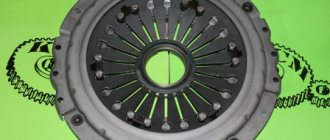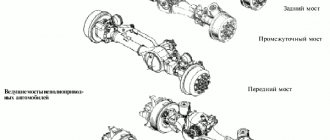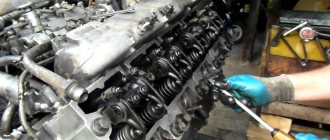Engine Kamaz-740.50-360. Engine composition, design and operation.
Content:
Operating principle of the KAMAZ-740 engine
The KAMAZ 740.50-360 engine is a four-stroke compression ignition, liquid-cooled, V-shaped engine with eight cylinders, turbocharged and intercooled air-to-air intercooling.
Cross section of a KAMAZ-740 engine
1 – full-flow oil purification filter; 2 – oil filler neck; 3 - oil level indicator; 4 – centrifugal oil filter; 5 - thermostat box; 6 – front eye bolt; 7 – compressor; 8 - power steering pump; 9 – rear eye bolt; 10 – left water pipe; 11 – torch candle; 12- left intake air duct; 13 – nozzle; 14 – nozzle mounting bracket; 15 – exhaust manifold pipe; 16 – exhaust manifold.
Longitudinal section of a KamAZ engine
1 – generator; 2 – low pressure fuel pump; 3 – manual fuel priming pump; 4 – high pressure fuel pump; 5 – automatic fuel injection advance clutch; 6-half coupling driving the high pressure fuel pump; 7-connecting pipe for inlet air ducts; 8 – fine fuel filter; 9 – cam shaft; 10 - flywheel; 11 – flywheel housing; 12-drain plug; 13-engine crankcase; 14-crankshaft; 15 – oil pump; 16 – drive shaft of the leading part of the fluid coupling; 17 – generator drive pulley; 18-fan impeller.
Cylinder block
It is the main body part of the engine and is a cast iron. The block is artificially aged to relieve thermal stress so that the block retains the correct geometric shapes and dimensions during operation.
In the upper part of this block there are sockets for sleeves. The housing is equipped with channels and cavities for the passage of coolant. A crankshaft is installed at the bottom of the block. The crankcase has two technological holes for lubrication. Inside the unit has partitions with special stiffening ribs. Special bores are made in these partitions and crankcase walls, which are closed with lids. These parts serve as supports for the crankshaft.
On the lower belt there are two grooves for sealing rings, which prevent coolant from entering the engine oil sump cavity from the cooling cavity of the block.
Engine crankshaft
The crankshaft is made of high-quality steel and has five main and four connecting rod journals, hardened by high-frequency heat, which are interconnected by cheeks and mated to them with transition fillets.
For uniform alternation of working strokes, the location of the crankpins of the crankshaft is made at an angle of 90°. Two connecting rods are attached to each connecting rod journal of the KamAZ crankshaft: one for the right and one for the left rows of cylinders.
To balance inertial forces and reduce vibrations, the Kamaz crankshaft has six counterweights, stamped integrally with the crankshaft cheeks. In addition to the main counterweights, there are two additional removable counterweights 1 and 2, pressed onto the shaft, and their angular position relative to the crankshaft is determined by keys 5 and 6. A ball bearing is pressed into the bore of the crankshaft shank.
Design and operation of the lubrication system
The engine is equipped with a combined type lubrication system. Oil is supplied by injection, gravity or low pressure, depending on where the rubbing parts are located and under what conditions they operate.
From the oil pump the mixture is supplied to the filter, after which it enters the main lines. Next, oil is supplied to the cylinders, gas distribution mechanism, crankshaft, compressor and fuel pump. These parts are always subject to high friction and operate at elevated temperatures, so they require constant lubrication.
To lubricate the piston ring support, part of the oil is removed from the pistons and flows by gravity to the device, after which it flows into the pan. The hydraulic coupling is processed only if it is working: otherwise, the valve activated by the hydraulic power sensor is closed and the oil drains. From the pan, the lubricant flows into the oil receiver, and from there through the filter - again to the pump.
Supply system
The system consists of fuel storage tanks, fuel lines, a low pressure pump, engine injection pump and injectors. It ensures timely injection of diesel into the combustion chambers for timely fuel compression and proper engine operation.
Cooling system
The engine is equipped with a closed-type cooling system with forced circulation of coolant. The main units and components of the cooling system include: radiator, fan with viscous drive coupling, fan casing, fan shell, water channel housing, water pump, thermostats, channels and connecting pipelines for the passage of coolant.
A centrifugal pump supplies the coolant mixture. From there it goes to the cylinder heads: first to the left side, then to the right. Then it passes into the cylinder cavity, from where it moves under pressure to the cylinder head. After completing the full cycle, the mixture enters the thermostats. After this, depending on the position of the hydraulic pump coupling, it cools the device or drains into the radiator. Adjustment is carried out using hydraulic couplings.
General information
I would like to immediately note that this article will discuss the most popular engine - the 740. There are a large number of its modifications, which sometimes differ only in European environmental standards. We will look at the 740th Euro-2 engine.
It is quite difficult to remember the name of each internal combustion engine. For example, a KamAZ with a 740-210 (260) engine is better known among motorists as KamAZ Euro-2 (3.4), where the last numbers indicate the volume of the power unit. If necessary, in the tables with technical characteristics you can find the desired motor with a specific European standard. Well, now let's go further and look at the basic information on the 740th internal combustion engine.
How to change oil
There is nothing complicated here, everything is approximately the same as in a passenger car. But first I would like to say a few words about the level. The manufacturer recommends checking the level before each trip. If there is not enough oil, then you cannot drive like this, because the wear of rubbing parts will increase significantly. It is advisable to add lubricant and only then continue driving. If an overflow occurs, then here too it is necessary to return the level to normal. This can be done by unscrewing the drain plug in the crankcase.
The process itself looks like this:
- warm up the internal combustion engine to operating temperature;
- turn off the engine and unscrew the crankcase plug;
- change filters;
- it is advisable to rinse the rotor with centrifugal grease cleaning;
- fill the oil up to about on the dipstick;
- start the engine and let it run for 5 minutes at idle;
- turn off and check the level, top up if necessary.
A little about the benefits
Despite the fact that there are a variety of malfunctions of the KamAZ engine (Euro-2), it is rightfully considered one of the most reliable among domestic ones. In addition, it is not too gluttonous and has quite compact dimensions. The designers managed to find a “golden mean”, which allowed them to further develop the design of the motor and gradually improve it.
Of course, these are not all of its advantages, because there are a whole lot of them:
- maintainability;
- interchangeability of main internal combustion engine parts;
- compliance with European environmental standards;
- quite good power;
- low fuel consumption.
It is also worth highlighting another important point - easy starting at sub-zero temperatures. Usually it is quite difficult to start a diesel engine in severe frost, but KamAZ is equipped with a powerful battery and starter. There is also a standard internal combustion engine heating system.
Let's sum it up
There are a huge number of faults that are inherent in this motor. Although it cannot be said that the 740 has sore spots. These are typical problems that appear not only on this model, but also on many others.
In general, the engine, which is equipped with a particulate filter - catalytic converter, is quite powerful and torquey. Such a power unit, with proper maintenance and gentle operation, can run quite a lot. Moreover, it does not require expensive maintenance. You just need to change filters, oils, other fluids and consumables on time. Even if any problem appears, it can be quickly and easily eliminated, if it does not concern the piston group of the engine. Despite the fact that the 740 was developed a long time ago, its modifications are still in use today.
Basic malfunctions and their elimination
The new KamAZ Euro-2 engine is unlikely to fail. It usually runs about 1 million kilometers before a major overhaul with proper maintenance. In practice, the power unit runs an order of magnitude less. This is due to the low quality of spare parts for maintenance, failure to meet deadlines for replacing fluid in the cooling system, oil, etc. As for the most typical problems, the following are worth highlighting:
- Insufficient oil pressure in the system. The most common cause is the oil pump or wear of the bearings. It should be understood that overheating of the lubricant can lead to a loss of pressure. Therefore, the first thing we do is check the pressure relief valve.
- Increased fuel consumption. The norm is considered to be about 35-40 liters of diesel fuel, although the car’s passport says something completely different. In the urban cycle, an 8% increase in consumption is permissible; if you have a trailer, then even more. Most often, consumption increases due to used oil or clogged filter elements.
Despite the fairly simple and well-known cooling system, problems very often occur with it. It is because of a malfunction of any component that the motor overheats, which can lead to major repairs. It is recommended to start checking with the antifreeze level and the operability of the thermostats.
“Zhor” of oil and what to do about it
We have already looked a little at the design of the KamAZ Euro-2 engine, and, as you have already noticed, this power unit has many problems. But despite this, it is considered quite reliable. Still, it is necessary to be able to determine the cause of the malfunction in time, then it will be possible to get by with minor repairs.
One of these reasons is increased lubricant consumption. On KamAZ, oil most often escapes through oil seals and leaky gaskets. It's worse when the lubricant burns excessively in the chamber. This indicates increased wear of the oil scraper rings and other problems. In this case, it is necessary to remove the KamAZ Euro-2 engine block and rebuild it.
Unstable operation, knocking, smoke
If the power unit vibrates strongly, and this can be with a warm or cold engine, idling or under load, then in this case several systems need to be checked. Firstly, the injection valves of the injection pump may be faulty or the injectors may be acting up. If the crankshaft was replaced before, then most likely there is a problem with its balancing.
The most common cause of knocking is oil starvation of the internal combustion engine. This can happen not only due to an insufficient amount of lubricant in the system, but also due to poor quality of the lubricant. In this case, the crankshaft usually jams and the liners rotate. As for smoke, it often appears due to a broken cylinder head gasket. White exhaust at sub-zero temperatures on a cold internal combustion engine is normal. In general, the KamAZ Euro-2 engine, the photo of which you can see, requires regular replacement of the air filter. If it is clogged, black smoke may appear.
